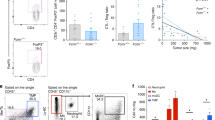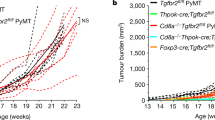Abstract
The apoptosis-inducing Fas ligand (FasL) is expressed in a variety of human cancers and has been implicated in tumor immune evasion. Paradoxically, ectopic expression of FasL in experimental tumors triggers a neutrophil-mediated inflammatory response and tumor rejection. To resolve these conflicting findings, we have established B16 melanoma and P29 Lewis lung carcinoma lines expressing different levels of FasL and examined their tumorigenicity in vivo. While tumors with a high level of FasL were rapidly rejected as previously reported, those expressing a low level of FasL were not rejected but grew faster than did FasL-negative parental cells. The growth enhancement of FasLlow tumors was not observed in T-cell-deficient nude mice, suggesting that FasL expressed in tumors at low levels counteracted against T-cell-dependent antitumor responses. In support of this notion, FasLlow tumors were found to grow faster than parental cells in mice that had acquired tumor-specific immunity. Furthermore, histological examinations revealed apoptosis of lymphocytes in tissue sections of FasLlow tumors. These results collectively suggest that FasL on tumors is a double-edged sword: at high levels it triggers tumor rejection whereas at low levels it facilitates tumor growth possibly by suppressing antitumor immune responses.
This is a preview of subscription content, access via your institution
Access options
Subscribe to this journal
Receive 12 print issues and online access
$259.00 per year
only $21.58 per issue
Buy this article
- Purchase on Springer Link
- Instant access to full article PDF
Prices may be subject to local taxes which are calculated during checkout






Similar content being viewed by others
Abbreviations
- FasL:
-
Fas ligand
- CD40L:
-
CD40 ligand
- PI:
-
propidium iodide
- TUNEL:
-
terminal deoxynucleotidyl transferase-mediated dUTP-biotin nick end labeling
- H&E:
-
hematoxylin and eosin
References
Nagata S, Suda T . Fas and Fas ligand: lpr and gld mutations. Immunol Today 1995; 16: 39–43.
Wang J, Watanabe T . Expression and function of Fas during differentiation and activation of B cells. Int Rev Immunol 1999; 18: 367–379.
Askenasy N, Yolcu ES, Yaniv I, Shirwan H . Induction of tolerance using Fas ligand: a double-edged immunotherapy. Blood 2005; 105: 1396–1404.
Griffith TS, Brunner T, Fletcher SM, Green DR, Ferguson TA . Fas ligand-induced apoptosis as a mechanism of immune privilege. Science 1995; 270: 1189–1192.
Griffith TS, Yu X, Herndon JM, Green DR, Ferguson TA . CD95-induced apoptosis of lymphocytes in an immune privileged site induces immunological tolerance. Immunity 1996; 5: 7–16.
Bellgrau D, Gold D, Selawry H, Moorer J, Franzusoff A, Duke RC . A role for CD95 ligand in preventing graft rejection. Nature 1995; 377: 630–632.
Reimer T, Herrnring C, Koczan D, Richter D, Gerber B, Kabelitz D et al. FasL:Fas ratio – a prognostic factor in breast carcinomas. Cancer Res 2000; 60: 822–828.
Mottolese M, Buglioni S, Bracalenti C, Cardarelli MA, Ciabocco L, Giannarelli D et al. Prognostic relevance of altered Fas (CD95)-system in human breast cancer. Int J Cancer 2000; 89: 127–132.
Munakata S, Enomoto T, Tsujimoto M, Otsuki Y, Miwa H, Kanno H et al. Expressions of Fas ligand and other apoptosis-related genes and their prognostic significance in epithelial ovarian neoplasms. Br J Cancer 2000; 82: 1446–1452.
Ito Y, Monden M, Takeda T, Eguchi H, Umeshita K, Nagano H et al. The status of Fas and Fas ligand expression can predict recurrence of hepatocellular carcinoma. Br J Cancer 2000; 82: 1211–1217.
O'Connell J, Bennett MW, O'Sullivan GC, Collins JK, Shanahan F . The Fas counterattack: cancer as a site of immune privilege. Immunol Today 1999; 20: 46–52.
O'Connell J, Houston A, Bennett MW, O'Sullivan GC, Shanahan F . Immune privilege or inflammation? Insights into the Fas ligand enigma. Nat Med 2001; 7: 271–274.
Seino K, Kayagaki N, Okumura K, Yagita H . Antitumor effect of locally produced CD95 ligand. Nat Med 1997; 3: 165–170.
Kang SM, Schneider DB, Lin Z, Hanahan D, Dichek DA, Stock PG et al. Fas ligand expression in islets of langerhans does not confer immune privilege and instead targets them for rapid destruction. Nat Med 1997; 3: 738–743.
Drozdzik M, Qian C, Lasarte JJ, Bilbao R, Prieto J . Antitumor effect of allogenic fibroblasts engineered to express Fas ligand (FasL). Gene Therapy 1998; 5: 1622–1630.
Hohlbaum AM, Moe S, Marshak-Rothstein A . Opposing effects of transmembrane and soluble Fas ligand expression on inflammation and tumor cell survival. J Exp Med 2000; 191: 1209–1220.
Restifo NP . Not so Fas: re-evaluating the mechanisms of immune privilege and tumor escape. Nat Med 2000; 6: 493–495.
Restifo NP . Countering the ‘counterattack’ hypothesis. Nat Med 2001; 7: 259.
Takenaga K . Characterization of low- and high-metastatic clones isolated from a Lewis lung carcinoma. Gann 1984; 75: 61–71.
Wang J, Koizumi T, Watanabe T . Altered antigen receptor signaling and impaired Fas-mediated apoptosis of B cells in Lyn-deficient mice. J Exp Med 1996; 184: 831–838.
Tada Y, O-Wang J, Takiguchi Y, Tatsumi K, Kuriyama T, Okada S et al. Cutting edge: a novel role for Fas ligand in facilitating antigen acquisition by dendritic cells. J Immunol 2002; 169: 2241–2245.
Seino K, Iwabuchi A, Kayagaki N, Miyata R, Nagaoka I, Matsuzawa A et al. Cutting edge: chemotactic activity of soluble Fas ligand against phagocytes. J Immunol 1998; 161: 4484–4488.
Tada Y, O-Wang J, Seimiya M, Takiguchi Y, Tatsumi K, Kuriyama T et al. Antitumor effects are produced by forced expression of membrane-bound but not soluble Fas ligand in murine lung carcinoma cells. Anticancer Res 2002; 22: 831–836.
Barnhart BC, Legembre P, Pietras E, Bubici C, Franzoso G, Peter ME . CD95 ligand induces motility and invasiveness of apoptosis-resistant tumor cells. EMBO J 2004; 23: 3175–3185.
Hyer ML, Sudarshan S, Schwartz DA, Hannun Y, Dong J, Norris JS . Quantification and characterization of the bystander effect in prostate cancer cells following adenovirus-mediated FasL expression. Cancer Gene Ther 2003; 10: 330–339.
Acknowledgements
We thank Satoko Miyauchi for secretary assistance. This work was supported by Grants-in-aid for the 21st Century Center of Excellent (COE) Program of the Japanese Ministry of Education, Culture, Sports, Science and Technology, grant-in-aid for scientific research from Japan Society for the Promotion of Science and grant-in-aid from the Tsuchiya Foundation and the Futaba Electronics Memorial Foundation.
Author information
Authors and Affiliations
Corresponding author
Rights and permissions
About this article
Cite this article
Wada, A., Tada, Y., Kawamura, K. et al. The effects of FasL on inflammation and tumor survival are dependent on its expression levels. Cancer Gene Ther 14, 262–267 (2007). https://doi.org/10.1038/sj.cgt.7701008
Received:
Revised:
Accepted:
Published:
Issue Date:
DOI: https://doi.org/10.1038/sj.cgt.7701008
Keywords
This article is cited by
-
Protumor and antitumor functions of neutrophil granulocytes
Seminars in Immunopathology (2013)
-
Inflammation, Apoptosis, and Necrosis Induced by Neoadjuvant Fas Ligand Gene Therapy Improves Survival of Dogs With Spontaneous Bone Cancer
Molecular Therapy (2012)
-
The immunoregulatory mechanisms of carcinoma for its survival and development
Journal of Experimental & Clinical Cancer Research (2011)



